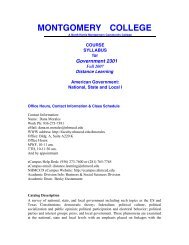2008 - Communication Across the Curriculum (CAC)
2008 - Communication Across the Curriculum (CAC)
2008 - Communication Across the Curriculum (CAC)
You also want an ePaper? Increase the reach of your titles
YUMPU automatically turns print PDFs into web optimized ePapers that Google loves.
H u m a n i t i e s<br />
The Gift of Song<br />
by Kirsten<br />
Hallford<br />
HUMA 1302: Introduction to <strong>the</strong> Humanities. Kirsten<br />
Hallford undertook to compose and write <strong>the</strong> lyrics<br />
for two pieces of music, greatly indebted to <strong>the</strong> age<br />
of <strong>the</strong> Italian and nor<strong>the</strong>rn European Renaissance, as<br />
well as <strong>the</strong> Islamic cultures. Her essay, in which she<br />
provides both historical and cultural background to<br />
<strong>the</strong> lyrics she wrote, is intended to accompany her<br />
songs.<br />
Adele Yung<br />
Music has been around for as long as people have had vocal<br />
chords. Singing is universal. We sing to celebrate, to entertain,<br />
to mourn, and to inspire. We sing on Broadway, in <strong>the</strong> shower, at<br />
school, at church, in a group or by ourselves. There are so many<br />
different ways to sing and types of music to sing to, it would take<br />
up countless books to categorize. The music of <strong>the</strong> times of <strong>the</strong><br />
European Renaissance is to be noted, however, because it is one of<br />
<strong>the</strong> first time periods where <strong>the</strong>ir melodies have been carried to our<br />
time. This fascinating era introduced new musical ideas, including<br />
<strong>the</strong> madrigal, <strong>the</strong> ballade, and <strong>the</strong> round.<br />
When I decided to write a Renaissance song, I first wanted to<br />
do a madrigal, “a poetic and musical form. The poem was usually<br />
of two or three stanzas, each one three lines long, followed by a<br />
refrain of two rhyming lines. The music was usually for two voices or<br />
parts, sometimes for three, and <strong>the</strong> melody for <strong>the</strong> stanzas differed<br />
from <strong>the</strong> melody for <strong>the</strong> refrain.” (web – “singers”) I liked <strong>the</strong> idea of<br />
more than two voices singing, and also putting to music Patriarch’s<br />
sonnets. Romantic and cute, <strong>the</strong> madrigal would be something I<br />
would want to sing were I in Renaissance times. But continuing to<br />
reflect made me decide I wanted to write my own song, with my<br />
own lyrics, accompanied by my own guitar (or, “oversized lute”).<br />
What was supposed to be as a love sonnet to music became a<br />
story of sorts. It’s sung by a young, romantic teen girl who lived in<br />
Venice, and is an account of her encounter with a handsome young<br />
sailor who just came off <strong>the</strong> deck his ship. They flirt a little, and he<br />
soon is gone, leaving her with dreams in her head. My madrigal had<br />
become a short ballade, but with <strong>the</strong> nonsensical words in-between<br />
<strong>the</strong> verses, typical of a madrigal. Simple and innocent, I deemed it<br />
<strong>the</strong> first “Badrigal” – not <strong>the</strong> catchiest name, but served its purpose.<br />
I attempted to put a couple Renaissance-song characteristics into<br />
one song, and it worked out fairly nicely. …Why not try it again<br />
I knew my second song was to be about Christmas, or at least<br />
6 3<br />
W r i t i n g A c r o s s t h e C u r r i c u l u m






